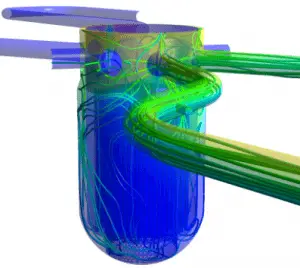Article Summary & FAQs
What is fluid dynamics?
In physics, fluid dynamics is a subdiscipline of fluid mechanics that deals with fluid flow. Fluid dynamics is one of the most important of all areas of physics.
Key Facts
- Conservation of mass in fluid dynamics states that all mass flow rates into a control volume are equal to all mass flow rates out of the control volume plus the rate of mass change within the control volume.
- Bernoulli’s equation can be considered a statement of the conservation of energy principle appropriate for flowing fluids.
- The Reynolds number is one of the characteristic numbers used for predicting whether a flow condition will be laminar or turbulent. It is defined as the ratio of inertial forces to viscous forces.
- Head loss of the hydraulic system is divided into two main categories:
- Major Head Loss – due to friction in straight pipes
- Minor Head Loss – due to components as valves, bends…
- Darcy’s equation can be used to calculate major losses. The friction factor for fluid flow can be determined using a Moody chart.
- In fluid dynamics, drag is a force acting opposite to the relative motion of any moving object. The force a flowing fluid exerts on a body in the flow direction.
- By definition, multiphase flow is the interactive flow of two or more distinct phases with common interfaces in, say, a conduit.
- Centrifugal pumps are devices that are used to transport fluids by the conversion of rotational kinetic energy to the hydrodynamic energy of the fluid flow.
Fluid Dynamics

Source: CFD development group – hzdr.de
In physics, fluid dynamics is a subdiscipline of fluid mechanics that deals with fluid flow. Fluid dynamics is one of the most important of all areas of physics. Life as we know it would not exist without fluids and without the behavior that fluids exhibit. The air we breathe and the water we drink (which makes up most of our body mass) are fluids. Fluid dynamics has many applications, including calculating forces and moments on aircraft (aerodynamics) and determining water’s mass flow rate through pipelines (hydrodynamics).
Fluid dynamics are an important part of most industrial processes, especially those involving the
transfer of heat. In nuclear reactors, the heat removal from the reactor core is accomplished by passing a liquid or gaseous coolant through the core and other regions where heat is generated. The nature and operation of the coolant system are among the most important considerations in designing a nuclear reactor.
Fluid flow in the nuclear field can be complex and is not always subject to rigorous mathematical analysis. Unlike solids, the particles of fluids move through piping and components at different velocities and are often subjected to different accelerations. The foundational axioms of fluid dynamics are the conservation laws, specifically, conservation of mass (leading to the continuity equation), conservation of linear momentum, and conservation of energy.